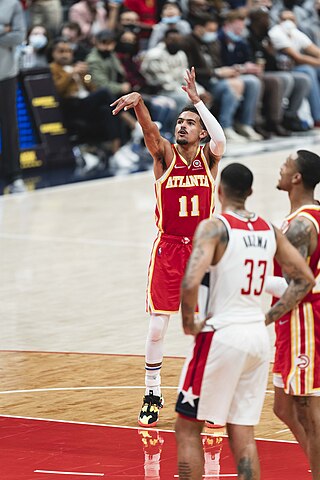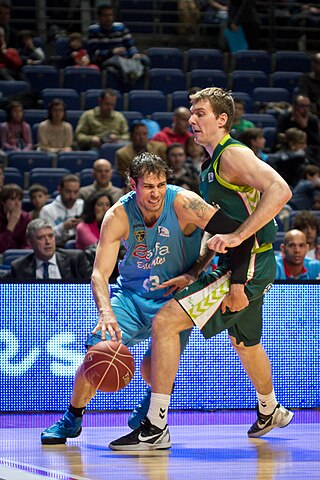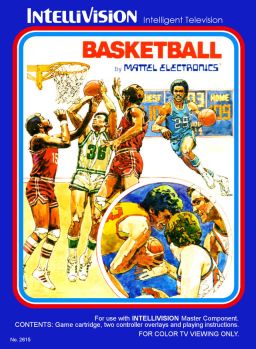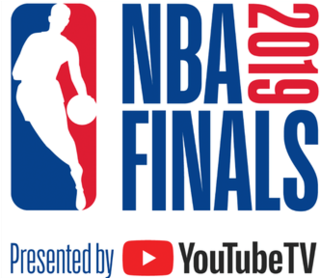
Basketball is a team sport in which two teams, most commonly of five players each, opposing one another on a rectangular court, compete with the primary objective of shooting a basketball through the defender's hoop, while preventing the opposing team from shooting through their own hoop. A field goal is worth two points, unless made from behind the three-point line, when it is worth three. After a foul, timed play stops and the player fouled or designated to shoot a technical foul is given one, two or three one-point free throws. The team with the most points at the end of the game wins, but if regulation play expires with the score tied, an additional period of play (overtime) is mandated.
In basketball, a technical foul is any infraction of the rules penalized as a foul which does not involve physical contact during the course of play between opposing players on the court, or is a foul by a non-player. The most common technical foul is for unsportsmanlike conduct. Technical fouls can be assessed against players, bench personnel, the entire team, or even the crowd. These fouls, and their penalties, are more serious than a personal foul, but not necessarily as serious as a flagrant foul.

In basketball, free throws or foul shots are unopposed attempts to score points by shooting from behind the free-throw line, a line situated at the end of the restricted area. Free throws are generally awarded after a foul on the shooter by the opposing team, analogous to penalty shots in other team sports. Free throws are also awarded in other situations, including technical fouls, and when the fouling team has entered the bonus/penalty situation. Also, depending on the situation, a player may be awarded between one and three free throws. Each successful free throw is worth one point.

In basketball, a personal foul is a breach of the rules that concerns illegal personal contact with an opponent. It is the most common type of foul in basketball. A player fouls out on reaching a limit on personal fouls for the game and is disqualified from participation in the remainder of the game.

The rules of basketball are the rules and regulations that govern the play, officiating, equipment and procedures of basketball. While many of the basic rules are uniform throughout the world, variations do exist. Most leagues or governing bodies in North America, the most important of which are the National Basketball Association and NCAA, formulate their own rules. In addition, the Technical Commission of the International Basketball Federation (FIBA) determines rules for international play; most leagues outside North America use the complete FIBA ruleset.

The pick and roll in basketball is an offensive play in which a player sets a screen (pick) for a teammate handling the ball and then moves toward the basket (rolls) to receive a pass. In the NBA, the play came into vogue in the 1990s and has developed into the league's most common offensive action. There are, however, many ways in which the defense can also counter the offensive screen.

In basketball, there are five players that play per team, each assigned to positions. Historically, these players have been assigned to positions defined by the role they play on the court, from a strategic point of view. The three main positions are guard, forward, and center, with the standard team featuring two guards, two forwards, and a center. Over time, as more specialized roles developed, each of the guards and forwards came to be differentiated, and today each of the five positions is known by a unique name and number: point guard (PG) or 1, the shooting guard (SG) or 2, the small forward (SF) or 3, the power forward (PF) or 4, and the center (C) or 5.
Zone defense is a type of defense, used in team sports, which is the alternative to man-to-man defense; instead of each player guarding a corresponding player on the other team, each defensive player is given an area to cover.
Man-to-man defense, or man defense, is a type of defensive technique used in team sports such as American football, association football, basketball, and netball, in which each player is assigned to defend and follow the movements of a single player on offense. Often, a player guards his counterpart, but a player may be assigned to guard a different position. However, the strategy is not rigid, and a player might switch assignment if needed, or leave his own assignment for a moment to double team an offensive player. The term is commonly used in both men's and women's sports. The alternative to man-to-man defense is zone defense, a system of defense in which each player guards an assigned area rather than a specified opponent.

Marc Gasol Sáez is a Spanish professional basketball player for Bàsquet Girona of the Liga ACB. The center is a two-time All-NBA Team member and a three-time NBA All-Star. He was named the NBA Defensive Player of the Year with the Memphis Grizzlies in 2013, and won an NBA championship with the Toronto Raptors in 2019.

This glossary of basketball terms is a list of definitions of terms used in the game of basketball. Like any other major sport, basketball features its own extensive vocabulary of unique words and phrases used by players, coaches, sports journalists, commentators, and fans.

In basketball, a foul is an infraction of the rules more serious than a violation. Most fouls occur as a result of illegal personal contact with an opponent and/or unsportsmanlike behavior. Fouls can result in one or more of the following penalties:
The triangle-and-two defense is a particular type of defense used in basketball.
The game of lacrosse is played using a combination of offensive and defensive strategies. Offensively, the objective of the game is to score by shooting the ball into an opponent's goal, using the lacrosse stick to catch, carry, and pass the ball. Defensively, the objective is to keep the opposing team from scoring and to dispossess them of the ball through the use of stick checking and body contact or positioning.

The 2–3 zone defense is a defensive strategy used in basketball as an alternative to man-to-man defense. It is referred to as the 2–3 because of its formation on the court, which consists of two players at the front of the defense and three players behind.

Basketball is a multiplayer sports video game produced by Mattel and released for its Intellivision video game system in 1980. The players each control a basketball team competing in four timed quarters of game play. Mattel obtained a license from National Basketball Association and used the NBA logo in its box art, making it first basketball video game to be licensed by the NBA. NBA Basketball does not use any official team or player names. It was sold by Sears for its private-label version of the Intellivision console, the "Super Video Arcade," without the NBA name or logo.
Basketball is a ball game and team sport in which two teams of five players try to score points by throwing or "shooting" a ball through the top of a basketball hoop while following a set of rules. Since being developed by James Naismith as a non-contact game that almost anyone can play, basketball has undergone many different rule variations, eventually evolving into the NBA-style game known today. Basketball is one of the most popular and widely viewed sports in the world.

Draymond Jamal Green Sr. is an American professional basketball player for the Golden State Warriors of the National Basketball Association (NBA). Green, who plays primarily at the power forward position, is a four-time NBA champion, a four-time NBA All-Star, a two-time member of the All-NBA Team, a seven-time member of the All-Defensive Team and a two-time Olympic gold medalist. In 2017, he won the NBA Defensive Player of the Year Award and led the league in steals.

Fredderick Edmund VanVleet Sr. is an American professional basketball player for the Toronto Raptors of the National Basketball Association (NBA).

The 2019 NBA Finals was the championship series of the National Basketball Association's (NBA) 2018–19 season and conclusion of the season's playoffs. In the best-of-seven playoff series held from May 30 through June 13, 2019, the Eastern Conference champion Toronto Raptors defeated the two-time defending NBA champion Golden State Warriors, , earning the franchise its first NBA championship as well as the first win by an NBA team based outside the United States. Acquired by the Raptors via a trade during the off-season, Kawhi Leonard was named the NBA Finals Most Valuable Player (MVP) for the second time in his career.













